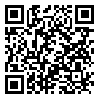Fri, Jun 6, 2025
[Archive]
Volume 11, Issue 2 (Spring 2025)
JCCNC 2025, 11(2): 125-136 |
Back to browse issues page
Download citation:
BibTeX | RIS | EndNote | Medlars | ProCite | Reference Manager | RefWorks
Send citation to:



BibTeX | RIS | EndNote | Medlars | ProCite | Reference Manager | RefWorks
Send citation to:
Mirlohi S, Keyvanloo Shahrestanaki S, Haghani S, Najafi Ghezeljeh T. The Effects of Smartphone-based Learning on the Knowledge, Attitude, and Perception of Disaster Preparedness Among Nurses. JCCNC 2025; 11 (2) :125-136
URL: http://jccnc.iums.ac.ir/article-1-607-en.html
URL: http://jccnc.iums.ac.ir/article-1-607-en.html
SeyedRohallah Mirlohi1 

 , Sahar Keyvanloo Shahrestanaki2
, Sahar Keyvanloo Shahrestanaki2 

 , Shima Haghani3
, Shima Haghani3 

 , Tahereh Najafi Ghezeljeh *4
, Tahereh Najafi Ghezeljeh *4 




 , Sahar Keyvanloo Shahrestanaki2
, Sahar Keyvanloo Shahrestanaki2 

 , Shima Haghani3
, Shima Haghani3 

 , Tahereh Najafi Ghezeljeh *4
, Tahereh Najafi Ghezeljeh *4 


1- Department of Critical Care Nursing, School of Nursing and Midwifery, Iran University of Medical Sciences, Tehran, Iran.
2- Department of Community Health Nursing and Geriatric Nursing, Nursing and Midwifery Care Research Center, School of Nursing and Midwifery, Tehran University of Medical Sciences, Tehran, Iran.
3- Nursing Care Research Center, Iran University of Medical Sciences, Tehran, Iran.
4- School of Nursing and Midwifery, Nursing and Midwifery Care Research Institute, Iran University of Medical Sciences, Tehran, Iran. ,taherehpaniz@yahoo.com
2- Department of Community Health Nursing and Geriatric Nursing, Nursing and Midwifery Care Research Center, School of Nursing and Midwifery, Tehran University of Medical Sciences, Tehran, Iran.
3- Nursing Care Research Center, Iran University of Medical Sciences, Tehran, Iran.
4- School of Nursing and Midwifery, Nursing and Midwifery Care Research Institute, Iran University of Medical Sciences, Tehran, Iran. ,
Abstract: (813 Views)
Background: The increasing reliance on technology in various fields has prompted the exploration of smartphone-based learning as a viable educational tool, particularly in the health care sector. Given the significant challenges posed by the COVID-19 pandemic, enhancing nurses’ readiness to respond effectively to disasters and health crises has become more critical. This study aims to evaluate the effects of smartphone-based learning on nurses’ knowledge, attitude, and perception regarding disaster preparedness.
Methods: This quasi-experimental study used a pre-test-post-test design with a control group in Falavarjan City, Iran, urban hospitals from June to September 2020. All 204 eligible nurses in the study settings were recruited and randomly allocated to either a control (n=102) or an intervention (n=102) group. An educational Android app was designed and provided to the intervention group for one month. The subjects completed the disaster preparedness evaluation tool and the disaster preparedness questionnaire before and one month after the intervention. The data analysis used descriptive statistics (absolute and relative frequencies, Mean±SD) and inferential statistics (analysis of variance, the independent t-test, paired t-test, and the chi-square test). The study utilized SPSS software, version 22, and a significance level of 0.05 was considered for all statistical tests.
Results: The groups showed no significant differences regarding the pre-test mean scores of disaster preparedness knowledge, attitude, and perception. No significant difference was also seen in the post-test mean score of disaster preparedness knowledge and attitude (P=0.20). However, the post-test mean score of disaster preparedness perception in the intervention group was greater than that in the control group (P<0.001).
Conclusion: Smartphone-based learning can promote nurses’ disaster preparedness perception, particularly during the COVID-19 pandemic.
Methods: This quasi-experimental study used a pre-test-post-test design with a control group in Falavarjan City, Iran, urban hospitals from June to September 2020. All 204 eligible nurses in the study settings were recruited and randomly allocated to either a control (n=102) or an intervention (n=102) group. An educational Android app was designed and provided to the intervention group for one month. The subjects completed the disaster preparedness evaluation tool and the disaster preparedness questionnaire before and one month after the intervention. The data analysis used descriptive statistics (absolute and relative frequencies, Mean±SD) and inferential statistics (analysis of variance, the independent t-test, paired t-test, and the chi-square test). The study utilized SPSS software, version 22, and a significance level of 0.05 was considered for all statistical tests.
Results: The groups showed no significant differences regarding the pre-test mean scores of disaster preparedness knowledge, attitude, and perception. No significant difference was also seen in the post-test mean score of disaster preparedness knowledge and attitude (P=0.20). However, the post-test mean score of disaster preparedness perception in the intervention group was greater than that in the control group (P<0.001).
Conclusion: Smartphone-based learning can promote nurses’ disaster preparedness perception, particularly during the COVID-19 pandemic.
Type of Study: Research |
Subject:
Special
Received: 2024/05/6 | Accepted: 2024/11/11 | Published: 2025/05/1
Received: 2024/05/6 | Accepted: 2024/11/11 | Published: 2025/05/1
Send email to the article author
| Rights and permissions | |
 |
This work is licensed under a Creative Commons Attribution-NonCommercial 4.0 International License. |



